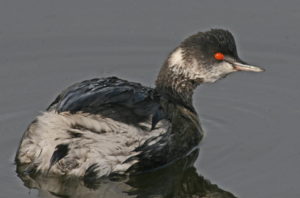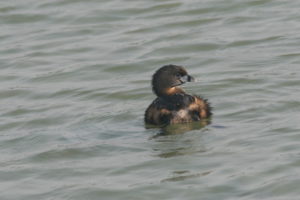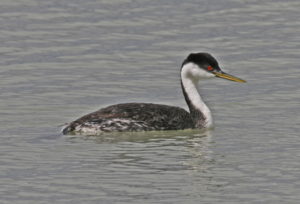Grebes make up the family Podicipedidae, a relatively small group of diving water birds that are found worldwide. Unlike ducks, they have lobed toes, legs that are far back on the body of the bird, and are ungainly on land where they are seldom seen unless sick. There are 22 species in the world, seven are in North America, and all but one recorded in Inyo and Mono Counties. The Least Grebe, mainly a neotropical species, has been documented in California at the Colorado River, where it has nested, and at the Salton Sea. There is a published report of one captured alive near Baker, San Bernardino County, in the fall of 1961 (Audubon Field Notes 16:73). No report or details were ever submitted to the California Bird Records Committee, which was not in existence in 1961, and therefore has not been accepted as a state record (Rare Birds of California, 2007:80). This casual species is on the CBRC Review List.
Of the six grebe species that occur in the Eastern Sierra, four have nested and occur regularly, one is rare to very uncommon (e.g., Horned Grebe) and the other is casual and not recorded every year (e.g., Red-necked Grebe). In the following thumbnail sketches the data are from North American Birds, Birds of Yosemite and the East Slope by David Gaines, and reports submitted by birders to the Inyo County Avian Archives.
Eared Grebe (Podiceps nigricollis) is a common spring and fall migrant, fairly common non-breeding summer visitor and rare to uncommon winter visitor in Inyo County in ponds, lakes, reservoirs, and in the Owens River. There are historical breeding records but none recently. There are recent reports of one thousand or more birds although the maximum count was in June 1891 when A.K. Fisher reported 35,000 dead birds along the shores of Owens Lake (Fisher 1893:12). Although most reports are from the Owens Valley or lower elevations, the highest elevation record is a specimen from 9132ft/2784m at Lake Sabrina (Los Angeles County Museum 103499).In Mono County, the Eared Grebe is common from April to November and uncommon December to March. It has bred at Crowley Lake and Bridgeport Reservoir and up to 35,000 non-breeding birds have summered at Mono Lake. The numbers at Mono Lake in the fall offer one of North America’s spectacular wildlife observations when hundreds of thousands have been recorded. In September 1973, over one million birds were estimated to be on Mono Lake (American Birds 28:98). Although most reports are from Bridgeport, Crowley, and Mono Lakes, there are high elevation recordssuch as the bird recorded at 11,000ft/3354m on Summit Lake 24 July 1975 (T&J Heindel, American Birds 29:1025). Albino or highly leucistic birds have been recorded in both counties.
Pied-billed Grebe (Podilymbus podiceps) is fairly common all months in Inyo County in ponds, lakes, reservoirs, and in the Owens River. Nesting occurs annually and in winter, when lakes, ponds, and reservoirs freeze the species either moves to the Owens River or departs to more southerly climates where open water exists. Most reports are below 4000ft/1220m but these small submarines have been found up to 10,500ft/3200m at Flower Lake 11 August 1997 (A.D. Kirk, pers. comm.). The maximum count is 121 birds at Haiwee Reservoir 14 Dec 1994 (T&J Heindel).In Mono County, the Pied-billed Grebe is uncommon late March through September and common in October and November when fall migrants from northern latitudes move south. A high elevation bird was at 8900ft/2713m at Lake Mary and the maximum count was 70 birds at Crowley Lake.
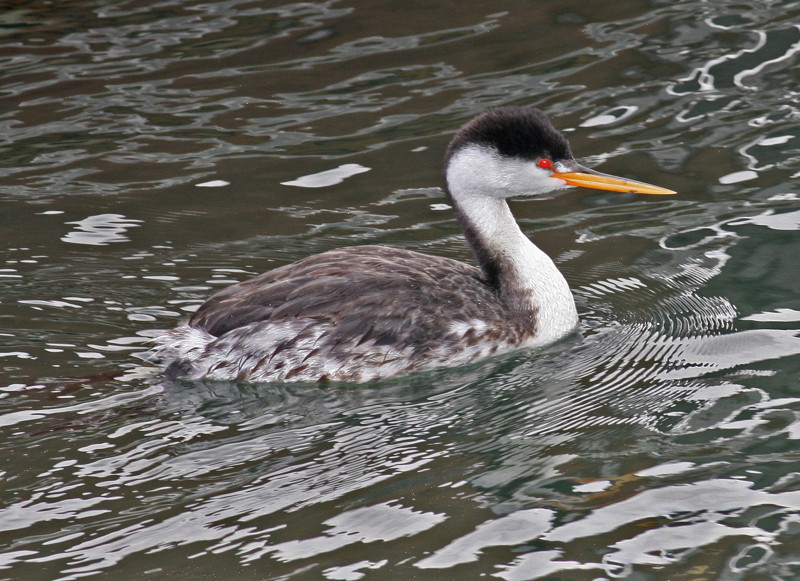
Clark’s Grebe, photo by Tom Heindel
Clark’s Grebe (Aechmophorus clarkii) is a fairly common migrant and summer resident in Inyo County in ponds, lakes, reservoirs, and in the Owens River. Breeding is annual at Klondike Lake. This species was not recognized until 1985, obscuring much of the history and early records prior to that time. It was considered a light morph of the Western Grebe and most birders and ornithologists did not record color morphs when they noted Western Grebes. The high elevation record is 4400ft/1341m at Pleasant Valley Reservoir (T&J Heindel) and the maximum count is 84 birds at Klondike Lake and Tinemaha Reservoir 6 October 1993 (T&J Heindel).
In Mono County, the Clark’s Grebeis an uncommon to fairly common migrant and summer visitor with nesting reported from Bridgeport Reservoir and Crowley Lake. Elevational data are below 7500ft/2287m and we have no data on maximum counts.
Western Grebe (Aechmophorus occidentalis) is an uncommon to fairly common migrant in Inyo County in ponds, lakes, reservoirs, and in the Owens River. It is a rare to very uncommon summer visitor with one breeding record at Klondike Lake 13 July 1997 when an adult was attending a juvenile (T&J Heindel). Many years in late summer they have attempted to breed at Tinemaha Reservoir but nests were destroyed by high winds or low water levels. Most records are from the Owens Valley or lower elevations. The high elevation record is 9132ft/2784m at Lake Sabrina (C.C. Honer, pers. comm.) and the maximum count is 102 birds at Haiwee Reservoir 24 November 1997 with a couple other records of 100 birds, always at reservoirs (T&J Heindel).In Mono County, Western Grebe is a common migrant and summer resident that breeds at Crowley Lake and Bridgeport Reservoir. The species has been recorded as high as 10,100ft/3079m at Saddlebags Lake 23 October 1978 (American Birds 33:209).
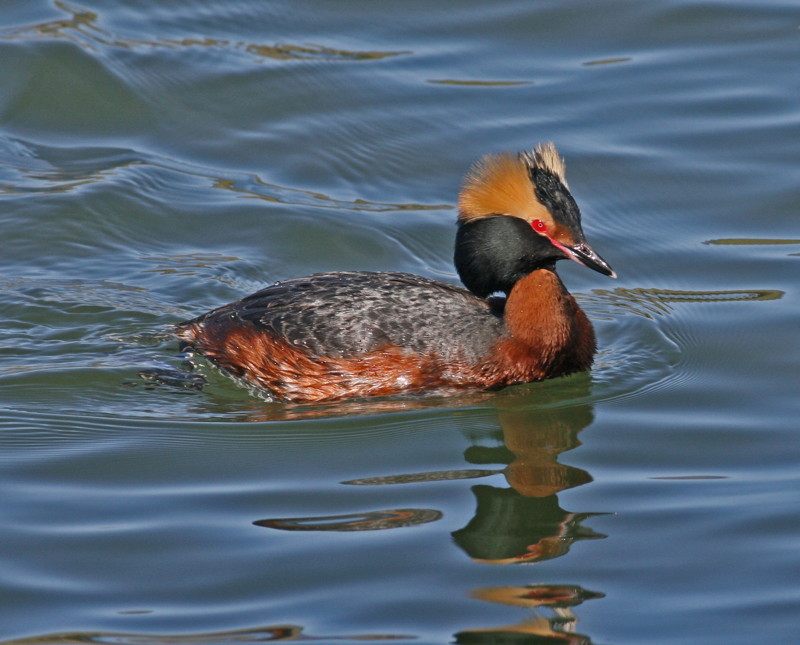
Horned Grebe, photo by Tom Heindel
Horned Grebe (Podiceps auritus) is a rare spring and fall migrant in Inyo County in ponds, lakes, reservoirs, and in the Owens River. Most records are from 4400ft/1341m or lower with two higher records in October (different years) in Deep Springs Valley at 5200ft/1585m (T&J Heindel). The maximum count is six birds when one was at Tinemaha Reservoir and five at Haiwee Reservoir 24 November 1994 (R.G. McCaskie, pers. comm.).
In Mono County, Horned Grebe is a very rare spring migrant and summer visitor and uncommon fall migrant October to early December. Most reports are from Mono and Crowley Lakes and Bridgeport Reservoir with others up to 8000ft/2439m and a maximum count of 20 birds at Mono Lake.
Red-necked Grebe (Podiceps grisegena) is a casual, not recorded every year, vagrant with five records in Inyo County at ponds, lakes, and reservoirs.The three fall records occurred 6 November 1977 at Stovepipe Wells (N.B. Broadbooks, G.S. Suffel; American Birds 32:256), 12-24 November at Haiwee Reservoir (M.A. Patten, Field Notes 49:99), and 16-19 November 2003 at Tinemaha Reservoir (J.L. Dunn, North American Birds 58:142); the two spring records are 29 April to 2 May 2009 at Klondike Lake (T&J Heindel, North American Birds 63:503) and 31 May 2004 at Tinemaha Reservoir (T&J Heindel, North American Birds 58:432).In Mono County, Red-necked Grebe is a casual vagrant with two records at Topaz Lake. One bird was there 13 March 1976 (J.L. Dunn, American Birds 30:760) and another there 31 October to 1 November 2007 (R. Hassey, North American Birds 62:145).
If observers in the Eastern Sierra feel they are looking at either of the last two grebe species, they need to submit supporting documentation, photographs and/or descriptions, to the county coordinators for North American Birds. These species, especially when not in alternate plumage designed to attract mates, can be a challenge to identify. All current field guides provide the characteristics necessary to “nail” your claim to the record book.
Tags: duck, grebe, lark

